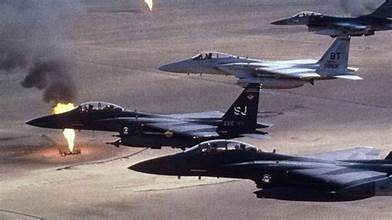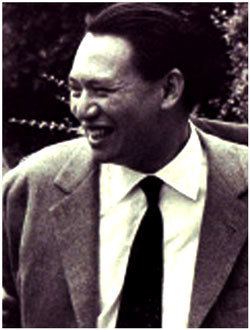In late 2003, Iran was actually trying to come to a peaceful settlement on Iraq. Iran was open to the idea of allowing a divided Iraq like how Korea was (at the time) still divided. A meeting was set to be held in Muscat in Oman in March 2004 to discuss the division of Iraq and the fate of Kuwait. But on January 2, 2004, Iranian President Akbar Rafsanjani was assassinated in the Iraqi town of Al Kut. There was a breakdown of negotiations between Iran and Saudi Arabia. More hardline forces in Iran exerted an increasing amount of influence over the government. Meanwhile, fighting in Iraq continued. Pro-Iran and pro-Saudi forces clashed as they both entered the remaining Republic of Iraq strongholds. Turkey and Syria both agreed to help Iran deal with Kurdish rebels in the North of Iraq.
The Battle of Babylon became the catalyst for the escalation of the conflict. Babil Province had been one of the final remaining areas where the old Iraqi Army still held control. From December 2003 to January 2004, Iranian and pro-Iranian forces won a decisive victory against both the Republic of Iraq and new Saudi-backed Kingdom of Iraq. Pro-Iran forces, heavily outnumbering their pro-Saudi counterparts, launched a series of mostly victorious offensives across the front line. All-out war had broken out between Iran and Saudi Arabia. In February, Fallujah fell and Iran began its invasion of Kuwait. Saudi Arabia and its allies had little hope of keeping control of any part of Iraq unless they received foreign help. Fortunately for Saudi Arabia, it had a lot more friends than Iran.
The Saudi-backed Kingdom of Iraq was gaining international recognition. By February 2004, it had won the recognition of the UK, China, Japan, Russia-Belarus, most of the Islamic world, and dozens of countries in Africa and Latin America. Saudi Arabia, Jordan, Egypt, and the United Arab Emirates were directly involved in supporting the Kingdom of Iraq in some way or another. The Iran-backed Islamic Republic of Iraq had the recognition of Pakistan, Syria, and Turkey. Turkmenistan, Azerbaijan, and Armenia recognized the Islamic Republic of Iraq, though more out of a desire to appease Iran therefore and prevent Iranian aggression against themselves. Switzerland and Italy decided to recognize both. Much of the world was undecided, notably India, the United States, and France.
Saudi Arabia, Jordan, and Egypt were actively engaged in an undeclared war against Iran. China had been blockading Iranian ports since the previous year, but was not engaged in combat. Nevertheless, China did send thousands of soldiers to Saudi Arabia. In March, Kuwait City fell, and anti-Iranian forces continued to lose ground in Iraq. Saudi Arabia was under threat. The United States and Britain both issued strong condemnations of Iran, and the United Nations voted to officially condemn Iran’s “war of aggression” in Iraq. In the United States, this led to some criticism of the Al Gore administration for its previous support of Iran. However, the US media was able to spin Iran’s actions as the work of Shia extremists in Iran taking over the formerly reasonable government. The United States, Canada, Australia, and Britain deployed troops to Saudi Arabia.
In late March, airplanes launched from Chinese aircraft carriers bombed Iranian military targets. Admiral Ma Yingjiu gained immense popularity from this war. Pro-Iran forces understood to not enter Saudi Arabia, but some Shia militants did rise up within Saudi Arabia itself. Saudi Arabia, the US, China, and their allies began to launch air raids into Iraq in April. Pro-Iranian forces were devastated. The Iranian Air Force could not compete. Ramadi, one of the last remaining major cities held by the Kingdom of Iraq, repelled the pro-Iranian attacks. The Allies would then start to push back. Syria had mobilized its troops for possible joint action with Iran, but was now discouraged from joining. A coalition of Saudi, Emirati, Jordanian, Royal Iraqi, Egyptian, Chinese, American, British, Canadian, and Australian forces launched offensives against Iran in May. Minor support was given by Russia-Belarus, France, New Zealand, Poland, Mongolia, South Korea, Colombia and Mexico as well.

(American planes)
The United States soon stopped sending weapons to the Kurds, though Israel would continue to smuggle weapons to them. American, British, and Chinese ground forces were small in number and stayed in Saudi Arabia. The West and China used their navies and air forces to attack Iran and Iranian-backed forces in Iraq. There were some exceptions, notably the joint Anglo-Sino-Saudia-American invasion of Kuwait, which restored Kuwaiti independence after 20 years of Iraqi occupation. The Kingdom of Iraq was upset by this but it was not about to oppose its allies. The UAE took control of some disputed islands in the Persian Gulf. Pro-Saudi forces began to regain lost territory as the Iranian air force could not compete with its enemies. Iran was exhausted and on the retreat. The flow of oil to the West and to East Asia was secured.
The Battle of Babylon became the catalyst for the escalation of the conflict. Babil Province had been one of the final remaining areas where the old Iraqi Army still held control. From December 2003 to January 2004, Iranian and pro-Iranian forces won a decisive victory against both the Republic of Iraq and new Saudi-backed Kingdom of Iraq. Pro-Iran forces, heavily outnumbering their pro-Saudi counterparts, launched a series of mostly victorious offensives across the front line. All-out war had broken out between Iran and Saudi Arabia. In February, Fallujah fell and Iran began its invasion of Kuwait. Saudi Arabia and its allies had little hope of keeping control of any part of Iraq unless they received foreign help. Fortunately for Saudi Arabia, it had a lot more friends than Iran.
The Saudi-backed Kingdom of Iraq was gaining international recognition. By February 2004, it had won the recognition of the UK, China, Japan, Russia-Belarus, most of the Islamic world, and dozens of countries in Africa and Latin America. Saudi Arabia, Jordan, Egypt, and the United Arab Emirates were directly involved in supporting the Kingdom of Iraq in some way or another. The Iran-backed Islamic Republic of Iraq had the recognition of Pakistan, Syria, and Turkey. Turkmenistan, Azerbaijan, and Armenia recognized the Islamic Republic of Iraq, though more out of a desire to appease Iran therefore and prevent Iranian aggression against themselves. Switzerland and Italy decided to recognize both. Much of the world was undecided, notably India, the United States, and France.
Saudi Arabia, Jordan, and Egypt were actively engaged in an undeclared war against Iran. China had been blockading Iranian ports since the previous year, but was not engaged in combat. Nevertheless, China did send thousands of soldiers to Saudi Arabia. In March, Kuwait City fell, and anti-Iranian forces continued to lose ground in Iraq. Saudi Arabia was under threat. The United States and Britain both issued strong condemnations of Iran, and the United Nations voted to officially condemn Iran’s “war of aggression” in Iraq. In the United States, this led to some criticism of the Al Gore administration for its previous support of Iran. However, the US media was able to spin Iran’s actions as the work of Shia extremists in Iran taking over the formerly reasonable government. The United States, Canada, Australia, and Britain deployed troops to Saudi Arabia.
In late March, airplanes launched from Chinese aircraft carriers bombed Iranian military targets. Admiral Ma Yingjiu gained immense popularity from this war. Pro-Iran forces understood to not enter Saudi Arabia, but some Shia militants did rise up within Saudi Arabia itself. Saudi Arabia, the US, China, and their allies began to launch air raids into Iraq in April. Pro-Iranian forces were devastated. The Iranian Air Force could not compete. Ramadi, one of the last remaining major cities held by the Kingdom of Iraq, repelled the pro-Iranian attacks. The Allies would then start to push back. Syria had mobilized its troops for possible joint action with Iran, but was now discouraged from joining. A coalition of Saudi, Emirati, Jordanian, Royal Iraqi, Egyptian, Chinese, American, British, Canadian, and Australian forces launched offensives against Iran in May. Minor support was given by Russia-Belarus, France, New Zealand, Poland, Mongolia, South Korea, Colombia and Mexico as well.
(American planes)
The United States soon stopped sending weapons to the Kurds, though Israel would continue to smuggle weapons to them. American, British, and Chinese ground forces were small in number and stayed in Saudi Arabia. The West and China used their navies and air forces to attack Iran and Iranian-backed forces in Iraq. There were some exceptions, notably the joint Anglo-Sino-Saudia-American invasion of Kuwait, which restored Kuwaiti independence after 20 years of Iraqi occupation. The Kingdom of Iraq was upset by this but it was not about to oppose its allies. The UAE took control of some disputed islands in the Persian Gulf. Pro-Saudi forces began to regain lost territory as the Iranian air force could not compete with its enemies. Iran was exhausted and on the retreat. The flow of oil to the West and to East Asia was secured.
